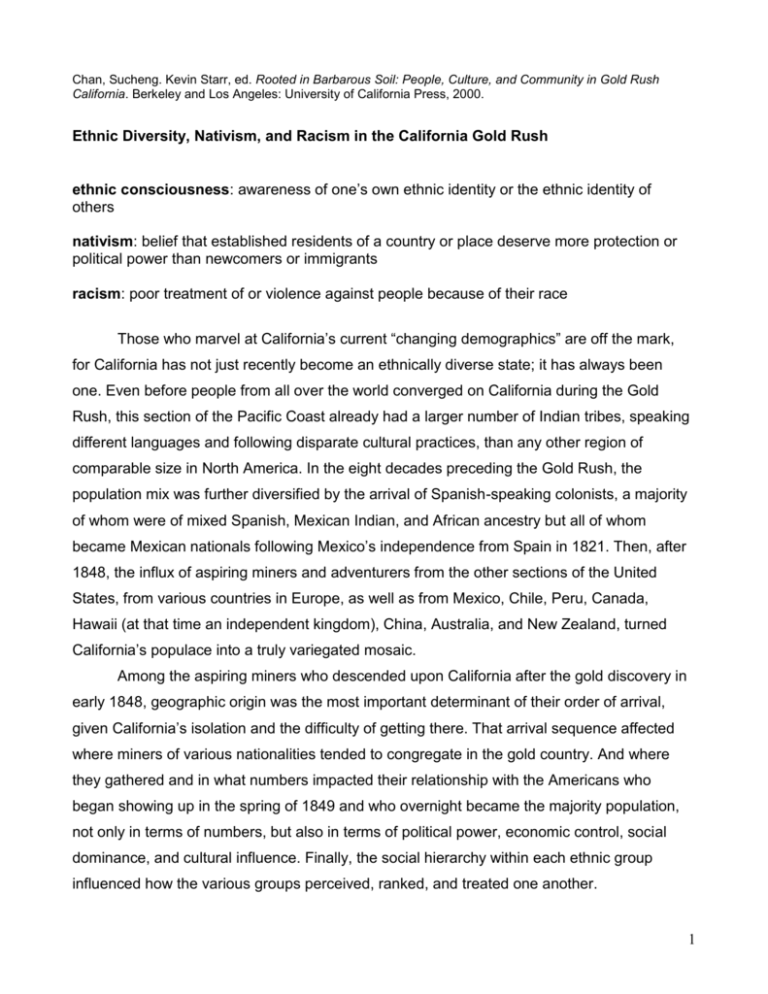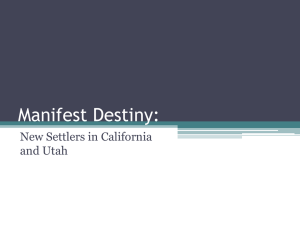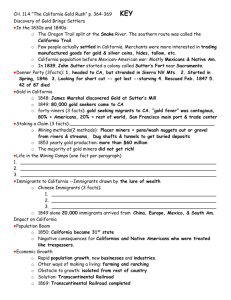Ethnic Diversity in the Gold Rush adapted
advertisement

Chan, Sucheng. Kevin Starr, ed. Rooted in Barbarous Soil: People, Culture, and Community in Gold Rush California. Berkeley and Los Angeles: University of California Press, 2000. Ethnic Diversity, Nativism, and Racism in the California Gold Rush ethnic consciousness: awareness of one’s own ethnic identity or the ethnic identity of others nativism: belief that established residents of a country or place deserve more protection or political power than newcomers or immigrants racism: poor treatment of or violence against people because of their race Those who marvel at California’s current “changing demographics” are off the mark, for California has not just recently become an ethnically diverse state; it has always been one. Even before people from all over the world converged on California during the Gold Rush, this section of the Pacific Coast already had a larger number of Indian tribes, speaking different languages and following disparate cultural practices, than any other region of comparable size in North America. In the eight decades preceding the Gold Rush, the population mix was further diversified by the arrival of Spanish-speaking colonists, a majority of whom were of mixed Spanish, Mexican Indian, and African ancestry but all of whom became Mexican nationals following Mexico’s independence from Spain in 1821. Then, after 1848, the influx of aspiring miners and adventurers from the other sections of the United States, from various countries in Europe, as well as from Mexico, Chile, Peru, Canada, Hawaii (at that time an independent kingdom), China, Australia, and New Zealand, turned California’s populace into a truly variegated mosaic. Among the aspiring miners who descended upon California after the gold discovery in early 1848, geographic origin was the most important determinant of their order of arrival, given California’s isolation and the difficulty of getting there. That arrival sequence affected where miners of various nationalities tended to congregate in the gold country. And where they gathered and in what numbers impacted their relationship with the Americans who began showing up in the spring of 1849 and who overnight became the majority population, not only in terms of numbers, but also in terms of political power, economic control, social dominance, and cultural influence. Finally, the social hierarchy within each ethnic group influenced how the various groups perceived, ranked, and treated one another. 1 The above aspects of Gold-Rush society did not remain static. Even though the unprecedented international migration lasted only half a dozen years, it can still be divided into three periods: (1) the first mining season of 1848, when surface gold was abundant, (2) the period from 1849 to the early 1850s, which was dominated by labor-intensive placer mining, and (3) the years after 1852 when mining became increasingly industrial and capitalintensive. In 1848, the state’s estimated population included perhaps 150,000 California Indians and between 14,000-15,000 non-Indians. Of the latter, slightly more than half were Americans and Europeans who drifted into Alta California in the quarter century before the discovery of gold. The rest were Californios. California Indians, Californios, and pre-Gold Rush settlers from the United States and Europe were the first prospectors to reach the gold fields in mid-1848. When the American military governor Col. Richard Mason toured the gold country in the summer of 1848, he estimated that half or more of the 4,000-plus miners he saw were California Indians. Some of them were laboring for Californios or Americans, while others were digging for themselves. The first foreign gold seekers to show up came from lands to the north, south, and west of California. Among the 6,000 plus people who made their way to California in 1848, foreigners outnumbered Americans. The first large contingent of Americans - an estimated 2,000-3,000 – came from Oregon. James Marshall’s find was first publicized in a Hawaiian newspaper on June 24, 1848. By mid-July signs of “gold fever” had broken out in Hawaii. That summer a large proportion of the Americans and Europeans residing in the islands, along with scores of native Hawaiians sailed for California. Trade grew along with the movement of people. All available clothing, shoes, raincoats, guns, bullets, etc. in Hawaii were shipped to California for sale at very high prices. Between 1848 and 1852 Hawaii, along with Oregon, Mexico, and Chile supplied the bulk of the food eaten in California’s gold country. Next came thousands of Mexicans and Chilenos and a smaller number of Peruvians. News of California’s gold strike first reached Chile on August 18,1848. The first forty five people to depart were American and English merchants who had settled in Chile. There are no reliable statistics on how many people from Chile joined the Gold Rush, and of those how many were English and American expatriates and how many were native Chilenos. However, we do know that by July 1849, the government had issued three 2 thousand passports to California bound emigrants. In addition, thousands had left without passports. The other sizable group of Latin Americans, Mexicans, traveled mainly overland or by a combination of land and sea routes. Of the 5,000-plus persons who came overland during the first mining season of 1848, 2,000-3,000 were from Mexico. Almost all hailed from the province of Sonora, with smaller numbers from Sinaloa, Chihuahua, and Durango. Many Sonorans were already familiar with California. During the Spanish period, they had comprised the bulk of the settlers sent north to colonize Alta California. Then they had flocked to southern California. In the first few months of 1849 an additional 6,000 Sonorans found their way to the mines. The Sonorans were seasonal migrants with at least half returning home at the end of each mining season. The smallest group of Latin Americans came from Peru. Peruvians first heard about Marshall’s find in the late fall of 1848. On November 30, the first ship with Peruvian passengers bound for California set sale. The number of Peruvian gold seekers is even more uncertain than the number of Chilenos and Mexicans. New Zealanders received the news in November 1848 when an American whaling ship put into port with several newspapers from Hawaii. Australians heard about the strike the following month when the Sydney Morning Herald reprinted stories from a Honolulu paper about the discovery. Once news filtered back of stories of people striking it rich, the exodus began. Thousands left. The Australian and New Zealand migration slowed to a trickle in 1851, when gold was discovered in Australia itself. The above were the groups who predated the Forty-Niners. Though the miners regardless of their national origins spread themselves out in search of rich deposits of gold, their location pattern was not entirely random. Discernible clusters of people emerged. For the most part, people from the same national or ethnic origins worked and lived together. A significant number of Canadians and Americans from Oregon dug in the Trinity-KlamathShasta region. American Forty-Niners who had crossed the Great Plains and the Rocky Mountains dominated the Northern Mines in Plumas, Butte, Sierra, Yuba, Nevada, Placer, El Dorado, and Amador counties. The largest contingent of Latin Americans prospected in the Southern Mines – in Calaveras, Tuolumne, and Mariposa counties. The Chinese began arriving after 1848. There is no reliable evidence on when news of the gold strike first reached China, but it was probably in late 1848, as ships from the United States, England, and Hawaii engaged in the China trade regularly. Canton became the chief 3 point of departure for Chinese emigrants to “Gold Mountain” the Chinese name for San Francisco. There were 54 Chinese in California in February 1, 1849, 791 by January 1, 1850, and around 4,000 by the end of 1850. Only when more than 20,000 Chinese landed in 1852 did large crowds of them fan out all over the mining counties. The various groups of miners were conscious of their ethnicity and drew distinctions between themselves and others by the names they used to refer to one another, by the clothing they wore, and by the religious faiths they professed. For example, Americans lumped all Spanish speakers together as “greasers,” while the latter called Americans and other people of European descent “gringos.” The longtime resident Californios distinguished themselves from the recently arrived Sonorans, calling the latter calzoneros blancos (white breeches) after the Sonorans’ flowing white pants. Despite their awareness of cultural differences, the miners of different national origins worked amicably alongside one another in the first mining season of 1848. It was a peaceful summer because there was plenty of gold to be had and foreign miners numbered only in the thousands. But conditions changed with the coming of the Forty-Niners, almost 90,000 of whom poured in that year – about 40,000 by sea and more than 40,000 overland. As these weary fortune hunters made their way to the mines, ethnic consciousness quickly became transformed first into nativism and then into racism. Unlike ethnic consciousness, nativism and racism were and are more than attitudes, feelings, and thoughts. Rather they were and are often manifested in action – action to discriminate against or harm members of other groups. American nativism – the fear of and hatred toward foreigners – has deep roots. AntiCatholicism was one of its cornerstones. Then during the American War of Independence the burgeoning nationalism felt by Americans made European traditions suspicious, so animosity toward foreigners, initially Europeans, was added to the antagonism toward the Pope. Up to the late 1840s, anti-Catholicism was directed mainly against Irish immigrants. Finally, the belief that the United States’ Anglo-Saxon heritage was what gave the nation its greatness added a racialist strain to American nativism. When the Forty-Niners finally reached the mines after an arduous journey, they were upset to find that Spanish-speaking miners had gotten there before them and seemed to have found the richest claims. In addition, among the miners were many veterans of the Mexican-American War, who had learned to see Mexicans as enemies. The nationalism and anti-Mexican stereotypes aroused during that conflict added fuel to the fire of nativism. 4 Because most of the Americans had no experience in gold mining, they were at first glad to learn from the Sonorans and Chilenos. Once they had acquired some knowledge, however, they became jealous of the latter’s success. Their nativist sentiments quickly found expression in action. First, the aspiring American miners formed local ad hoc associations and drew up regulations to govern how claims could be made and kept. In American miners’ eyes these practices did not apply to foreign “interlopers.” American miners felt that since the United States had gained possession of California as a result of the nation’s victory in the Mexican-American War, all the wealth in the state belonged to them. The American miners used two methods to drive the foreigners out – physical intimidation and discriminatory rules and laws. Initially, nativist sentiments applied across the board; even the British and Germans experienced antipathy. But once the expulsion campaign began, the English, Irish, and Germans lined up on the side of the Americans against the other foreigners, in the process solidifying their own standing as honorary Americans. In contrast, the French encountered hostility partly because of their apparent disinterest in adopting Anglo-American language and culture, partly because they kept mainly to themselves, and partly because of their friendly relations with the Latin American miners. The Foreign Miners Tax cost twenty dollars a month and was imposed on all foreign miners in April 1850. Since most miners averaged less than twenty dollars’ worth of gold a month, the tax would create enormous hardship on those required to pay it. Moreover, though it was supposed to be collected from all foreign miners, in fact, only certain foreigners – primarily French and Spanish speakers bore the brunt. Scholars have offered different explanations with regard to the motives of the legislators who levied the tax. Some think its intention was to exploit the foreigners. Others argued that it was to exclude them from the gold country altogether. Some believed its aim was to remove the competition, given the fact that the Sonorans and Chilenos were superior miners. More important than the motives of the legislators, was the law’s impact: the tax legally sanctioned the anti-foreign violence that had begun to emerge the year before and helped institutionalize a pattern of race relations that has persisted to the present day. The first nativist acts in the gold fields were resolutions passed by groups of American miners to keep foreigners out. Though these resolutions were passed everywhere in the mining country, the largest number appeared in the Southern Mines, where visible groups of 5 foreigners had congregated. In the spring of 1849, notices appeared there warning all nonU.S. citizens to leave within twenty-four hours. To enforce these resolutions, American miners often resorted to violence. During April 1849, Mexicans, Chilenos, and Peruvians were ordered to leave the area around Sutter’s Mill at Coloma. That summer, Sonorans were driven away from placer claims along the Tuolumne, Stanislaus, and Mokelumne rivers. Mexicans who had discovered the diggings in Mariposa County were evicted from their grounds. Such nativist actions, which had begun before the Foreign Miners’ Tax came into existence, became more frequent after it was levied because it sanctioned the expulsion of foreign miners who could not afford to or who refused to pay the tax. The tax collectors were often aided by bands of armed Americans who roamed the countryside terrorizing the foreign population. American and British miners were successful in these expulsion campaigns. Thousands of Latino and French miners left the gold country in 1850, 1851, and 1852. Some of the Spanish-speakers returned to their native lands while others went to San Francisco, to the smaller towns, or to the rural areas, especially in southern California, to earn a living. Those who remained in mining retreated to more remote areas where they hoped to escape molestation, or they survived by working for American miners or mining companies as lowpaid wage laborers. Their status as cheap workers only served to increase the hostility AngloAmerican miners felt toward them. Frenchmen also sought sanctuary in San Francisco. Eventually the exodus of the foreign miners hurt the businesses which had earned so much money from their purchases of goods and gambling. The legislature then repealed the Foreign Miners Tax in March 1851. Then a second Foreign Miners Tax was passed aimed at a new target – the Chinese, over 20,000 of whom landed in California in 1852. Their appearance coincided with a new stage in Gold Rush history, during which placer mining declined and capital-intensive methods of extracting gold using wage labor became ascendant. During this period the nativism that had been directed at the Latin Americans and French miners was now aimed at African Americans and Chinese, whose skin color and other features differed form those of white Anglo-Saxon Protestants. 6 Reading Questions 1. Describe the population of California in 1848, in your own words. 2. Describe the origins of the different groups of miners and the order in which they arrived. 3. The author gives the names groups had for each other as examples of “ethnic consciousness.” What were some of those names? 4. What two methods did American miners use to keep foreign miners out? Give an example of each. 5. Describe the progression from ethnic consciousness to nativism to racism, and give an example of each. 7





